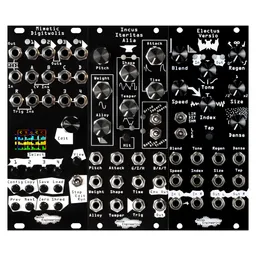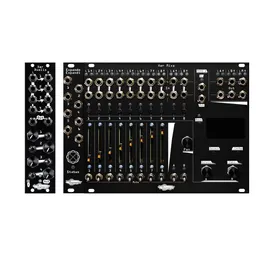When we’re patching, it’s common to use a single signal in multiple places. To do that, we need to make copies of our signal, and that’s where mults come in. In this episode of Getting Started, we’ll explore what mults are, the different types of mults, and how we can use them in our patches.
Split it up
Mults, short for “multiples”, are an extremely simple, yet extremely useful, utility. When you patch a signal to the input of a mult, you’ll get multiple copies of that signal at the output jacks. That’s really all they do: it’s like a copier for your signals.

A mult is a type of utility, but it’s also a piece of synth lingo: you may hear someone describe the act of copying a signal to multiple destinations as “multing”; “mult this envelope to a VCA and a filter,” for instance.
Types of mults
In Eurorack, there are three main types of mults: external mults, mult cables, and mult modules. These all take a variety of forms, but they all work in pretty much the same way: signal goes in, copies of that signal come out.
External mults
These are mults that live outside of your synth. This can be a great choice for smaller systems especially, as they don’t take up any HP. I often use these for connections that I don’t repatch often, such as clocks for all my sequencers. A great example of external mults are the Knucklebones by Hosa.

Mult cables
Mult cables come in a couple of forms, but the most common are stacking cables, like this Stackcable by TipTop Audio: these work the same as normal patch cables, but they feature jacks on the back of each end. This creates a copy of whatever jack you’ve patched out of right on top of the cable. And, just like external mults, these take up exactly 0 HP.

Mult modules
Mult modules are dedicated modules that live in your case and exist only to split signals. I have lots of mults in my system, as I generally prefer patching with them to external solutions, but they do take up some space.

Mult modules also have a unique characteristic: some mult modules are “active”. What’s that mean, exactly?
Active mults vs. passive mults
Mult cables, external mults, and some mult modules are passive, meaning that they don’t use power: they just make multiple connections from your source. When you do this, the strength of the signal is reduced slightly.
For a lot of things, that’s okay: for instance, if you’re multing a gate to two different envelopes, a difference in the voltage of the gate shouldn’t be an issue. Similarly, if you mult an LFO to a few destinations, you probably won’t notice a difference in the slightly reduced amplitude of the LFO.
However, if you need to mult a pitch signal, this can sometimes be an issue: differences of just a couple of hundredths of a volt in pitch CV can be audible, and you may run into a patch where something is tracking pitch incorrectly after being patched. To make sure that everything stays in tune, there are modules called active mults: these are powered modules that create precise copies of signals, useful for things like pitch CV that are especially sensitive to variation.
Applications
Mults can be used to split any type of signal in Eurorack. It's all voltage!
Gates and triggers
If you want to trigger two separate envelopes, say, a filter envelope and a VCA envelope with one gate, you could mult the gate to the two envelopes. Or, if you wanted to trigger two drum modules at the same time, you could mult a trigger signal to both of them.
Clock multing
Many Eurorack modules need a clock signal to work (more on clocking in a future post, too!). When syncing multiple modules together, you'll often want to mult a clock to multiple destination. For instance, if you want two sequencers to advance at the same time, a mult will do the trick.
Multing CV
Multing CV is one of the best ways to bring a patch to life. For instance, you could mult an envelope to a filter's cutoff, and the pulsewidth of an oscillator, and each time a note is played you'll have a dramatic timbral shift. If you wanted to modulate six destinations with the same LFO, you could do that with a lot of multing -- and yes, that’s totally a thing that you can and should do!
For advanced patchers: parallel processing
As we mentioned earlier, mults can be used with audio. This opens up some extremely fun possibilities, such as parallel processing with the aid of a mult and a mixer. Split your audio, mult one copy to a compressor, and patch the output and another copy to your mixer. This creates an effect called parallel compression, which is common in mixing and is a great way to punch up your percussion. This technique can be applied to any effect without a wet/dry blend, too!
You could also do something more out-of-the-box: for instance, run your audio through three different distortion or filter modules, then mix them back together for some complex new layers. I love running my signals through both a highpass and a lowpass filter with high resonance on each: it creates some really interesting effects, especially when the filters are modulated.
Looking for modules?
Here are just a few modules that can perform some of the functions we've been chatting about. There are always lots of choices in modular!
2hp Buff: Active mult in 2 HP.
2hp Mult: Passive mult in 2 HP.
Mutable Instruments Links: A collection of 3 utilities, including an active mult.
Hosa Knucklebones: A passive external mult.






